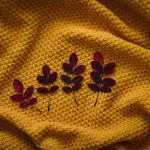Are you tired of seeing your favorite fabrics fade and bleed like watercolors on a canvas? Understanding the causes and solutions to color bleed is essential for maintaining the quality of your textiles.
In this guide, we will explore the factors that contribute to color transfer, the fabrics most susceptible to this issue, and effective methods for preventing and treating color bleed.
By mastering these techniques, you can preserve the vibrancy and longevity of your fabrics, ensuring that color bleed becomes a thing of the past.
Key Takeaways
- Color bleed can occur when fabrics are washed together, especially if they are made of different materials or haven't been properly color-set.
- Fabrics prone to color transfer should be washed separately in cold water before wearing.
- Using a color catcher sheet in the laundry can trap loose dyes and prevent them from staining other fabrics.
- Air-drying is preferable to using a dryer, as heat can exacerbate color bleed.
Understanding Color Bleed
Understand the causes and effects of color bleed to protect your fabrics from potential damage. Dye migration, also known as color bleed, occurs when dyes from one fabric transfer to another, leading to unintended color mixing. This can happen when fabrics are washed together, especially if they're made of different materials or haven't been properly color-set. Understanding dye migration is crucial for preventing color bleed and preserving fabric color retention.
To prevent color bleed, it's important to separate fabrics by color and material before washing. Always wash new, brightly colored, or heavily dyed fabrics separately to prevent the dyes from bleeding onto other items. Additionally, using cold water and a gentle detergent can help minimize dye migration. When in doubt, consider using color-catching sheets or towels in the laundry to trap loose dyes and prevent them from staining other fabrics.
Fabrics Prone to Color Transfer
Are you constantly finding color transfer on your clothes and linens?
Certain fabrics are more prone to color bleed and transfer, making it important to take extra care when washing and storing them.
Understanding which fabrics are more likely to transfer color can help you prevent color bleed and preserve the quality of your garments and home textiles.
Preventing Color Bleed
To prevent color bleed in fabrics prone to color transfer, wash them separately in cold water before wearing. This simple step can help prevent the dye migration that causes color bleed. Additionally, always check the care label for specific instructions on washing and drying to maintain the colorfastness of your clothing. Here's a table to illustrate the recommended washing practices for color-prone fabrics:
| Fabric Type | Washing Instructions |
|---|---|
| Delicate fabrics (silk, satin) | Hand wash in cold water with mild detergent |
| Dark-colored items | Wash inside out to minimize friction and color transfer |
| New garments | Wash separately for the first few washes to prevent color bleed |
Fabric Care Tips
When caring for fabrics prone to color transfer, it's important to follow specific washing and drying instructions to maintain their colorfastness and prevent any potential color bleed.
- Always wash these fabrics separately to avoid color transfer from other garments.
- Use cold water and a gentle detergent to minimize color bleed.
- Consider using a color catcher sheet in the wash to trap any loose dyes and prevent them from transferring onto your fabric.
When it comes to drying, air-drying is preferable to using a dryer, as heat can exacerbate color bleed.
- In case of stains, treat them promptly using a stain remover suitable for the fabric type.
Following these fabric care tips will help ensure the preservation of your garments and prevent color transfer mishaps.
Common Color Transfer
If you frequently encounter color bleed with your fabrics, understanding the common culprits behind color transfer is essential for preventing future mishaps. Certain fabrics are more prone to color transfer, such as denim, dark-colored fabrics, and synthetic materials.
To minimize color transfer, consider using fabric protection products specifically designed to prevent dyes from bleeding onto other fabrics. Additionally, be mindful of laundry mistakes that can exacerbate color transfer, such as washing dark and light-colored fabrics together, overloading the washing machine, or using excessive detergent.
By taking precautions and being attentive to the types of fabrics being laundered together, you can significantly reduce the risk of color transfer.
Causes of Color Bleed
Are you washing your colored fabrics with hot water and mixing them with white items? These practices can lead to color bleed, causing your fabrics to lose their vibrancy and potentially ruin other items in the wash. Understanding the causes of color bleed can help you prevent accidents and preserve the integrity of your colored fabrics.
Here are some common causes of color bleed to be mindful of:
- Hot Water: Washing colored fabrics in hot water can cause the dye to leach out more easily, leading to color bleed.
- Mixing with White Items: When colored fabrics are mixed with white items, especially during the dyeing process, the colors can bleed onto the white items, causing stains.
- Low-Quality Dyes: Fabrics dyed with low-quality or unstable dyes are more prone to color bleeding during washing.
- Overloading the Washer: Overcrowding the washing machine with too many items can lead to inadequate water and detergent distribution, increasing the likelihood of color bleed.
Understanding these causes can help you take proactive measures to prevent color bleed and preserve the quality of your fabrics.
Preventing Color Bleed
You can prevent color bleed in your fabrics by sorting them properly before washing. Start by separating light-colored fabrics from dark-colored ones to avoid dye transfer. Additionally, it's crucial to read the care labels on your garments to ensure you're using the appropriate washing method. When in doubt, it's best to wash delicate or colorful items separately.
Moreover, utilizing color-catching sheets or dye-trapping laundry products can help prevent color bleed by absorbing loose dyes in the water. Another effective strategy is to pre-treat your clothes before washing them. This involves soaking them in a mixture of cold water and white vinegar to set the dyes and reduce the chances of bleeding.
Furthermore, consider using fabric dyeing techniques such as color sealing or using a dye fixative to lock in the colors and prevent bleeding. By taking these preventative measures, you can maintain the vibrancy of your fabrics and minimize the risk of color bleed.
Treating Color Bleed
To effectively treat color bleed in your fabrics, it's essential to act promptly and use the appropriate methods to salvage the affected items. Here are some crucial steps to help you address color bleed effectively:
- Separate the Affected Items: Quickly remove the affected fabric from other items to prevent the spread of the color bleed.
- Rinse with Cold Water: Rinse the affected fabric with cold water to help remove excess dye. Avoid hot water, as it can set the dye further.
- Use Color Catcher Sheets: Consider using color catcher sheets when washing the affected fabric. These sheets can help absorb loose dyes and prevent them from redepositing onto other items.
- Consider Professional Help: If the color bleed is extensive or if the fabric is delicate, seeking professional assistance from a dry cleaner or textile expert may be necessary.
Maintaining Fabric Quality
To preserve the quality of your fabrics, focus on regular maintenance and proper care. Fabric preservation is key to ensuring that your fabrics remain in top condition. One important aspect of maintaining fabric quality is to conduct regular colorfastness testing. This will help you determine how resistant the fabric is to fading or bleeding. By knowing the colorfastness of your fabrics, you can take appropriate measures to preserve their color and overall quality.
In addition to colorfastness testing, proper care and maintenance routines are essential. Always follow the care instructions provided by the manufacturer, including washing, drying, and ironing guidelines. Using the correct cleaning agents and following recommended washing temperatures can significantly impact the longevity of your fabrics. Regularly inspect your fabrics for any signs of wear and tear, and address any issues promptly to prevent further damage.
Remember to store your fabrics properly, away from direct sunlight and in a clean, dry environment. By incorporating these fabric preservation practices into your routine, you can maintain the quality and integrity of your fabrics for years to come.
Frequently Asked Questions
Can Color Bleed Be Fixed by Using a Different Laundry Detergent?
Using a different laundry detergent can improve color bleed, but it's not a guaranteed fix. Consider using a detergent specifically designed for color protection or adding a color catcher sheet to the wash for alternative solutions.
How Can I Prevent Color Bleed When Washing Mixed Fabric Items?
To prevent color bleed when washing mixed fabric items, focus on fabric care and color protection. Use proper laundry techniques and test for colorfastness. This ensures your items stay vibrant and don't ruin each other in the wash.
Are There Any Specific Fabrics That Are More Prone to Color Transfer Than Others?
When choosing fabrics, consider colorfastness and the dyeing process. Some fabrics, like rayon and silk, are more prone to color transfer due to their construction. Select colorfast fabrics to avoid color bleed issues.
Can I Use Bleach to Remove Color Bleed Stains From My Fabrics?
You can use bleach alternatives to remove color bleed stains from your fabrics. Always test on a small, inconspicuous area first. Opt for colorfast fabrics to minimize risk. Follow care labels and use cold water to prevent color bleed.
What Are Some Common Mistakes People Make When Trying to Prevent or Treat Color Bleed in Their Fabrics?
When it comes to fabric care, best practices include testing for colorfastness before washing. Common mistakes people make are not sorting laundry properly and using the wrong water temperature. Follow these tips for better results.
- Tetron Fabric for Marine Applications: Durability and Use Cases - June 18, 2025
- Tetron Fabric for Outdoor Furniture: Weather Resistance and Care - June 18, 2025
- Tetron Fabric for Wall Coverings: Style and Application Tips - June 18, 2025






